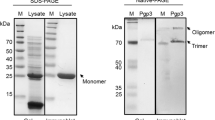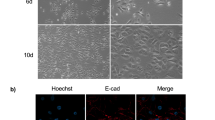Abstract
Aim and objective
The potential role of chlamydial heat shock proteins (cHSP) 60 and cHSP10 in apoptosis of primary cervical epithelial cells was investigated.
Methods
Primary cervical epithelial cells were stimulated with cHSP60 and cHSP10 for 4 h. Quantitative measurements of apoptosis were made using cytofluorometry, and apoptosis-related genes were analyzed by microarray, real-time PCR and western blotting. Further, levels of proinflammatory cytokines (IL-18 and IL-1β) were determined by semi-quantitative RT-PCR.
Results
After a 4-h incubation in the presence of recombinant cHSP60 or cHSP10, the number of cells exhibiting annexin V binding activity increased 6- and 5-fold, respectively (P < 0.05). A DNA microarray study showed significant (P < 0.05) upregulation of interleukin (IL)-1 β-convertase, and caspase-3, -8 and -9 genes in cHSP60- and cHSP10-stimulated than in control cells as confirmed by real-time RT-PCR and western blotting. Transcript levels of IL-1β and IL-18 in cells treated with cHSP60 and cHSP10 were found to be significantly (P < 0.05) higher in stimulated than in control cells.
Conclusion
cHSP60- and cHSP10-induced caspase expression, proinflammatory cytokine production and apoptosis of primary cervical epithelial cells might play a role in the pathogenesis of infertility in women with persistent chlamydial infection.





Similar content being viewed by others
References
Dean D, Suchland RJ, Stamm WE. Evidence for long-term cervical persistence of Chlamydia trachomatis by omp1 genotyping. J Infect Dis. 2000;182:909–16.
Moulder JW. Interaction of chlamydiae and host cells in vitro. Microbiol Rev. 1991;55:143–90.
Byrne GI, Ojcius DM. Chlamydia and apoptosis: life and death decisions of an intracellular pathogen. Nat Rev Microbiol. 2004;2:802–8.
Equils O, Lu D, Gatter M, Witkin SS, Bertolotto C, Arditi M, et al. Chlamydia heat shock protein 60 induces trophoblast apoptosis through TLR4. J Immunol. 2006;177:1257–63.
Neuer A, Lam KN, Tiller FW, Kiesel L, Witkin SS. Humoral immune response to membrane components of Chlamydia trachomatis and expression of human 60 kDa heat shock protein in follicular fluid of in vitro fertilization patients. Hum Reprod. 1997;12:925–9.
LaVerda D, Kalayoglu MV, Byrne GI. Chlamydial heat shock proteins and disease pathology: new paradigms for old problems? Infect Dis Obstet Gynecol. 1999;7:64–71.
Neuer A, Spandorfer SD, Giraldo P, Dieterle S, Rosenwaks Z, Witkin SS. The role of heat shock proteins in reproduction. Hum Reprod Update. 2000;6:149–59.
Follmann F, Olsen AW, Jensen KT, Hansen PR, Andersen P, Theisen M. Antigenic profiling of a Chlamydia trachomatis gene-expression library. J Infect Dis. 2008;197:897–905.
Brunham RC, Maclean IW, Binns B, Peeling RW. Chlamydia trachomatis: its role in tubal infertility. J Infect Dis. 1985;152:1275–82.
Brunham RC, Peeling R, Maclean I, Kosseim ML, Paraskevas M. Chlamydia trachomatis-associated ectopic pregnancy: serologic and histologic correlates. J Infect Dis. 1992;165:1076–81.
Toye B, Laferriere C, Claman P, Jessamine P, Peeling R. Association between antibody to the chlamydial heat-shock protein and tubal infertility. J Infect Dis. 1993;168:1236–40.
Freidank HM, Clad A, Herr AS, Wiedmann-Al-Ahmad M, Jung B. Immune response to Chlamydia trachomatis heat-shock protein in infertile female patients and influence of Chlamydia pneumoniae antibodies. Eur J Clin Microbiol Infect Dis. 1995;14:1063–9.
Arno JN, Yuan Y, Cleary RE, Morrison RP. Serologic responses of infertile women to the 60-kd chlamydial heat shock protein (hsp60). Fertil Steril. 1995;64:730–5.
Kimani J, Maclean IW, Bwayo JJ, MacDonald K, Oyugi J, Maitha GM, et al. Risk factors for Chlamydia trachomatis pelvic inflammatory disease among sex workers in Nairobi, Kenya. J Infect Dis. 1996;173:1437–44.
Eckert LO, Hawes SE, Wolner-Hanssen P, Money DM, Peeling RW, Brunham RC, et al. Prevalence and correlates of antibody to chlamydial heat shock protein in women attending sexually transmitted disease clinics and women with confirmed pelvic inflammatory disease. J Infect Dis. 1997;175:1453–8.
Peeling RW, Kimani J, Plummer F, Maclean I, Cheang M, Bwayo J, et al. Antibody to chlamydial hsp60 predicts an increased risk for chlamydial pelvic inflammatory disease. J Infect Dis. 1997;175:1153–8.
Claman P, Honey L, Peeling RW, Jessamine P, Toye B. The presence of serum antibody to the chlamydial heat shock protein (CHSP60) as a diagnostic test for tubal factor infertility. Fertil Steril. 1997;67:501–4.
Ault KA, Statland BD, King MM, Dozier DI, Joachims ML, Gunter J. Antibodies to the chlamydial 60 kilodalton heat shock protein in women with tubal factor infertility. Infect Dis Obstet Gynecol. 1998;6:163–7.
Cortinas P, Munoz MG, Loureiro CL, Pujol FH. Follicular fluid antibodies to Chlamydia trachomatis and human heat shock protein-60 kDa and infertility in women. Arch Med Res. 2004;35:121–5.
den Hartog JE, Land JA, Stassen FR, Kessels AG, Bruggeman CA. Serological markers of persistent C. trachomatis infections in women with tubal factor subfertility. Hum Reprod. 2005;20:986–90.
Betsou F, Sueur JM, Orfila J. Serological investigation of Chlamydia trachomatis heat shock protein 10. Infect Immun. 1999;67:5243–6.
LaVerda D, Albanese LN, Ruther PE, Morrison SG, Morrison RP, Ault KA, et al. Seroreactivity to Chlamydia trachomatis Hsp10 correlates with severity of human genital tract disease. Infect Immun. 2000;68:303–9.
Betsou F, Borrego MJ, Guillaume N, Catry MA, Romao S, Machado-Caetano JA, et al. Cross-reactivity between Chlamydia trachomatis heat shock protein 10 and early pregnancy factor. Clin Diagn Lab Immunol. 2003;10:446–50.
Jha R, Vardhan H, Bas S, Salhan S, Mittal A. Cervical epithelial cells from Chlamydia trachomatis-infected sites coexpress higher levels of chlamydial heat shock proteins 60 and 10 in infertile women than in fertile women. Gynecol Obstet Invest. 2009;68:160–6.
Reddy BS, Rastogi S, Das B, Salhan S, Verma S, Mittal A. Cytokine expression pattern in the genital tract of Chlamydia trachomatis positive infertile women—implication for T-cell responses. Clin Exp Immunol. 2004;137:552–8.
Bas S, Muzzin P, Vischer TL. Chlamydia trachomatis serology: diagnostic value of outer membrane protein 2 compared with that of other antigens. J Clin Microbiol. 2001;39:4082–5.
Perfettini JL, Ojcius DM, Andrews CW Jr, Korsmeyer SJ, Rank RG, Darville T. Role of proapoptotic BAX in propagation of Chlamydia muridarum (the mouse pneumonitis strain of Chlamydia trachomatis) and the host inflammatory response. J Biol Chem. 2003;278:9496–502.
Gerard HC, Krausse-Opatz B, Wang Z, Rudy D, Rao JP, Zeidler H, et al. Expression of Chlamydia trachomatis genes encoding products required for DNA synthesis and cell division during active versus persistent infection. Mol Microbiol. 2001;41:731–41.
Gerard HC, Freise J, Wang Z, Roberts G, Rudy D, Krauss-Opatz B, et al. Chlamydia trachomatis genes whose products are related to energy metabolism are expressed differentially in active vs. persistent infection. Microbes Infect. 2002;4:13–22.
de Gruijl TD, Bontkes HJ, van den Muysenberg AJ, van Oostveen JW, Stukart MJ, Verheijen RH, et al. Differences in cytokine mRNA profiles between premalignant and malignant lesions of the uterine cervix. Eur J Cancer. 1999;35:490–7.
Pizarro TT, Michie MH, Bentz M, Woraratanadharm J, Smith MF Jr, Foley E, et al. IL-18, a novel immunoregulatory cytokine, is up-regulated in Crohn’s disease: expression and localization in intestinal mucosal cells. J Immunol. 1999;162:6829–35.
Sasu S, LaVerda D, Qureshi N, Golenbock DT, Beasley D. Chlamydia pneumoniae and chlamydial heat shock protein 60 stimulate proliferation of human vascular smooth muscle cells via toll-like receptor 4 and p44/p42 mitogen-activated protein kinase activation. Circ Res. 2001;89:244–50.
Jobin C, Haskill S, Mayer L, Panja A, Sartor RB. Evidence for altered regulation of I kappa B alpha degradation in human colonic epithelial cells. J Immunol. 1997;158:226–34.
Samali A, Cai J, Zhivotovsky B, Jones DP, Orrenius S. Presence of a pre-apoptotic complex of pro-caspase-3, Hsp60 and Hsp10 in the mitochondrial fraction of jurkat cells. EMBO J. 1999;18:2040–8.
Chernesky M, Luinstra K, Sellors J, Schachter J, Moncada J, Caul O, et al. Can serology diagnose upper genital tract Chlamydia trachomatis infections? Studies on women with pelvic pain, with or without chlamydial plasmid DNA in endometrial biopsy tissue. Sex Transm Dis. 1998;25:14–9.
Paland N, Rajalingam K, Machuy N, Szczepek A, Wehrl W, Rudel T. NF-kappaB and inhibitor of apoptosis proteins are required for apoptosis resistance of epithelial cells persistently infected with Chlamydophila pneumoniae. Cell Microbiol. 2006;8:1643–55.
Kol A, Bourcier T, Lichtman AH, Libby P. Chlamydial and human heat shock protein 60s activate human vascular endothelium, smooth muscle cells, and macrophages. J Clin Invest. 1999;103:571–7.
Takenaka R, Yokota K, Ayada K, Mizuno M, Zhao Y, Fujinami Y, et al. Helicobacter pylori heat-shock protein 60 induces inflammatory responses through the Toll-like receptor-triggered pathway in cultured human gastric epithelial cells. Microbiology. 2004;150:3913–22.
Bulut Y, Faure E, Thomas L, Karahashi H, Michelsen KS, Equils O, et al. Chlamydial heat shock protein 60 activates macrophages and endothelial cells through Toll-like receptor 4 and MD2 in a MyD88-dependent pathway. J Immunol. 2002;168:1435–40.
Costa CP, Kirschning CJ, Busch D, Durr S, Jennen L, Heinzmann U, et al. Role of chlamydial heat shock protein 60 in the stimulation of innate immune cells by Chlamydia pneumoniae. Eur J Immunol. 2002;32:2460–70.
Da Costa CU, Wantia N, Kirschning CJ, Busch DH, Rodriguez N, Wagner H, et al. Heat shock protein 60 from Chlamydia pneumoniae elicits an unusual set of inflammatory responses via Toll-like receptor 2 and 4 in vivo. Eur J Immunol. 2004;34:2874–84.
Vabulas RM, Ahmad-Nejad P, da Costa C, Miethke T, Kirschning CJ, Hacker H, et al. Endocytosed HSP60s use toll-like receptor 2 (TLR2) and TLR4 to activate the toll/interleukin-1 receptor signaling pathway in innate immune cells. J Biol Chem. 2001;276:31332–9.
Fan W, Ha T, Li Y, Ozment-Skelton T, Williams DL, Kelley J, et al. Overexpression of TLR2 and TLR4 susceptibility to serum deprivation-induced apoptosis in CHO cells. Biochem Biophys Res Commun. 2005;337:840–8.
Janssens S, Beyaert R. A universal role for MyD88 in TLR/IL-1R-mediated signaling. Trends Biochem Sci. 2002;27:474–82.
Aliprantis AO, Yang RB, Weiss DS, Godowski P, Zychlinsky A. The apoptotic signaling pathway activated by Toll-like receptor-2. EMBO J. 2000;19:3325–36.
Cerretti DP, Hollingsworth LT, Kozlosky CJ, Valentine MB, Shapiro DN, Morris SW, et al. Molecular characterization of the gene for human interleukin-1 beta converting enzyme (IL1BC). Genomics. 1994;20:468–73.
Ghayur T, Banerjee S, Hugunin M, Butler D, Herzog L, Carter A, et al. Caspase-1 processes IFN-gamma-inducing factor and regulates LPS-induced IFN-gamma production. Nature. 1997;386:619–23.
Lu H, Shen C, Brunham RC. Chlamydia trachomatis infection of epithelial cells induces the activation of caspase-1 and release of mature IL-18. J Immunol. 2000;165:1463–9.
Cheng W, Shivshankar P, Li Z, Chen L, Yeh IT, Zhong G. Caspase-1 contributes to Chlamydia trachomatis-induced upper urogenital tract inflammatory pathologies without affecting the course of infection. Infect Immun. 2008;76:515–22.
Gao LY, Kwaik YA. The modulation of host cell apoptosis by intracellular bacterial pathogens. Trends Microbiol. 2000;8:306–13.
Hacker G, Fischer SF. Bacterial anti-apoptotic activities. FEMS Microbiol Lett. 2002;211:1–6.
Acknowledgments
We acknowledge the Indian Council of Medical Research for providing financial assistance to R.J. and H.V. in the form of a research fellowship. We also thank Mr. Shashi Kant for providing technical assistance and microarray data analysis at the International Centre for Genetic Engineering and Biotechnology (ICGEB), New Delhi, India.
Author information
Authors and Affiliations
Corresponding author
Additional information
Responsible Editor: Kumar Visvanathan.
Rights and permissions
About this article
Cite this article
Jha, R., Vardhan, H., Bas, S. et al. Chlamydia trachomatis heat shock proteins 60 and 10 induce apoptosis in endocervical epithelial cells. Inflamm. Res. 60, 69–78 (2011). https://doi.org/10.1007/s00011-010-0237-x
Received:
Accepted:
Published:
Issue Date:
DOI: https://doi.org/10.1007/s00011-010-0237-x




